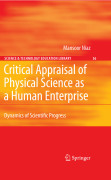
Critical appraisal of physical science as a humanenterprise: dynamics of scientific progress
Niaz, M.
The objective of this book is to reconstruct historical episodes and experiments that have been important in scientific progress, and to explore the role played by controversies and rivalries among scientists. Although progress in science has been replete with controversies, scientists themselves either ignoreor simply downplay their role. Such presentations lack the appreciation of the dynamics of ‘science-in-the-making’. This book provides methodological guidelines - based on a historical perspective of philosophy of science - that facilitate an understanding of historical episodes beyond that of inductive generalizations. These guidelines suggest that progress in science is not merely based on the accumulation of experimental data, but rather dependent on the creative imagination of the scientific community. This work shows that interpretation of experimental data is difficult and inevitably leads to alternative models/theories thus facilitating the understanding of science as a human enterprise. Presents historical reconstructions that are very different from textbook presentations Includes a wide range of historical episodes covering almost 300 years Provides guidelines for students, teachers and researchers for further research Understands science as a human enterprise INDICE: Dedication. Acknowledgments. 1. Introduction. 2. Quantitative imperative vs the imperative of presuppositions. 3. Understanding scientific progress: From Duhem to Lakatos. 4. Kinetic theory: Maxwell’s Presuppositions. 5. Periodic table of the chemical elements: >From Mendeleev to Moseley. 6. Foundations of modern atomic theory: Thomson, Rutherford, and Bohr . 7. Determinationof the elementary electrical charge: Millikan and Ehrenhaft. 8. Paradox of the photoelectric effect: Einstein and Millikan. 9. Bending of light in the 1919eclipse experiments: Einstein and Eddington. 10. Lewis’s covalent bond: From transfer of electrons to sharing of electrons. 11. Quantum mechanics: From Bohr to Bohm. 12. Wave-particle duality: De Broglie, Einstein and Schrödinger. 13. Searching for quarks: Perl’s philosophy of speculative experiments. 14. Conclusion: Inductive method as a chimera. References. Index.
- ISBN: 978-1-4020-9625-9
- Editorial: Springer
- Encuadernacion: Cartoné
- Páginas: 210
- Fecha Publicación: 01/03/2009
- Nº Volúmenes: 1
- Idioma: Inglés
